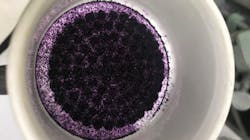Self-assembling traps capture PFAS
BUFFALO, NY -- University at Buffalo chemists have shown that self-assembling molecular traps can be used to capture PFAS — dangerous pollutants that have contaminated drinking water supplies around the world.
The traps are made from iron-based and organic building blocks that connect, like Legos, to form a tetrahedral cage. Experiments showed that these structures bind to certain PFAS (short for per- and polyfluoroalkyl substances), and a lab analysis revealed how this happens. As it turns out, the PFAS stick strongly to the outside of the cages instead of getting caught inside, researchers say.
These insights were detailed in a study released this month and could help scientists fine-tune the traps in favorable ways — for example, by enlarging the openings of the cages to potentially catch other types of PFAS. The eventual goal is to use such cages — known as metallacages — in systems that isolate PFAS from water, which could lead to better water treatment, or improved techniques for detecting the pollutants in water.
“PFAS are highly stable and toxic chemicals that can cause adverse human health effects,” says Diana Aga, PhD, Henry M. Woodburn Professor of Chemistry in the UB College of Arts and Sciences. “There is increasing evidence to suggest links between exposure to PFAS and adverse health outcomes in humans and animals, with potential effects including decreased birth weight, decreased fertility, and increased risk of diabetes and certain cancers, to name a few. The findings in our new paper are exciting because they provide evidence that the molecular traps are effective sorbents for some PFAS.”
“We're very excited about a few ways this work may evolve, from enabling the detection of PFAS that current analyses may miss, to altering the cages such that in addition to binding the PFAS, they also destroy them,” says Timothy Cook, PhD, assistant professor of chemistry in the UB College of Arts and Sciences.
Cook and Aga led the study, along with Cressa Ria P. Fulong, PhD, a recent Cook lab graduate, and Mary Grace E. Guardian, a PhD candidate in Aga's lab. All team members made important contributions, with Fulong and Guardian spearheading experimental and analytical work that took place in the lab.
The research was featured in the journal Inorganic Chemistry.
The traps capture a subset of PFAS
PFAS are not a single compound; they are a group of manmade chemicals that are used in food packaging, nonstick coatings, firefighting foams and other goods. Because the compounds don’t break down easily, they persist in the environment for a long time.
Numerous studies have detected PFAS in drinking water supplies worldwide, including a paper that Aga and colleagues published on May 19 in the journal Chemosphere. That project searched for the pollutants in the Philippines and Thailand and found them in surface waters, bottled water and water from re-fill stations. Other studies have shown that PFAS accumulate in people’s blood.
With these concerns in mind, Cook, Aga, Fulong and Guardian set out to learn whether molecular cages could help trap PFAS.
The scientists screened about a dozen different types of self-assembling cages that contain metals. Fulong synthesized the cages in Cook’s lab, and Guardian used advanced analytical techniques in Aga’s lab to study whether each structure was binding to PFAS.
This process led the team to the iron-based cages, which captured a subset of PFAS with chains of six or more fluorinated carbon atoms, including perfluorocarboxylic acids, sulfonic acids and fluorotelomers.
Next up? Tweaking the cages to trap more PFAS —and maybe destroy them
The study gives scientists new knowledge that could help them make experimental improvements to the cages. By tweaking the cages’ building blocks, researchers could potentially create structures that bind more strongly with PFAS, sponge up additional varieties of the pollutants, or even destroy the chemicals, Cook says.
“I’ve been reading reports in the popular media that people are trying to incinerate these PFAS, and it might be making the problem even worse,” Cook says. “It basically just sends them up into the air and disperses them even more. I’m wondering if we can develop cages with electro- or photochemical properties that will enable them to break up the bonds in PFAS.”
“I'm hopeful that the molecular traps can be designed to potentially capture the most highly water soluble PFAS that typically escape conventional water treatment technologies,” Aga says. “There are already many sorbents in use, such as activated carbon, that interact with PFAS. However, activated carbon does not have building blocks or pores that can be easily tuned — and this is the beauty of the metallacages.”
The study was funded in part by the National Science Foundation.
SOURCE: University at Buffalo
